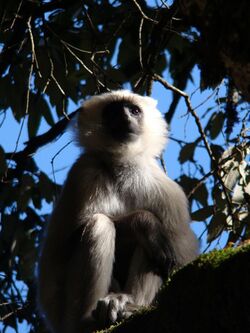Biology:Tarai gray langur
| Tarai gray langur | |
|---|---|

| |
| Tarai Gray langur at Kilbury Road Nainital | |
| Scientific classification Error creating thumbnail: Unable to save thumbnail to destination
| |
| Domain: | Eukaryota |
| Kingdom: | Animalia |
| Phylum: | Chordata |
| Class: | Mammalia |
| Order: | Primates |
| Suborder: | Haplorhini |
| Infraorder: | Simiiformes |
| Family: | Cercopithecidae |
| Genus: | Semnopithecus |
| Species: | S. hector[1]
|
| Binomial name | |
| Semnopithecus hector[1] Pocock, 1928
| |
Error creating thumbnail: Unable to save thumbnail to destination
| |
| Tarai gray langur range | |
The Tarai gray langur (Semnopithecus hector) is an Old World monkey, and was formerly considered a subspecies of the northern plains gray langur. The species is listed as near threatened, as there are probably not many more than 10,000 mature individuals, and it is experiencing a continuing decline.[2]
Distribution and habitat
The Tarai gray langur is native to northern India , Bhutan, and Nepal, and inhabits the Himalaya n foothills from Rajaji National Park to southwestern Bhutan. It also lives in the moist deciduous forest of the Siwalik Hills to oak forest ranging from altitudes of 150 to 1,600 m (490 to 5,250 ft).[2]
Behaviour and ecology
The Tarai gray langur is arboreal, mainly terrestrial, diurnal, folivorous, and lives in multi-male multi-female groups.[3] Groups have been observed feeding in orchards and crop fields outside of Rajaji National Park.[2]
References
- ↑ Groves, C.P. (2005). "Species Semnopithecus hector". in Wilson, D.E.; Reeder, D.M.. Mammal Species of the World: A Taxonomic and Geographic Reference (3rd ed.). Baltimore: Johns Hopkins University Press. p. 174. ISBN 0-801-88221-4. OCLC 62265494. http://www.departments.bucknell.edu/biology/resources/msw3/browse.asp?id=12100697.
- ↑ 2.0 2.1 2.2 2.3 2.4 Singh, M.; Kumar, A.; Kumara, H.N.; Ahuja, V. (2020). "Semnopithecus hector". IUCN Red List of Threatened Species 2020: e.T39837A17942651. doi:10.2305/IUCN.UK.2020-2.RLTS.T39837A17942651.en. https://www.iucnredlist.org/species/39837/17942651. Retrieved 17 January 2022.
- ↑ Molur, S.; Brandon-Jones, D.; Dittus, W.; Eudey, A.; Kumar, A.; Singh, M.; Feeroz, M. M.; Chalise, M. et al. (2003). Status of South Asian Primates: Conservation Assessment and Management Plan. Coimbatore: Zoo Outreach Organization and CBSG-South Asia. http://www.zooreach.org/downloads/ZOO_CAMP_PHVA_reports/2003%20Primate%20Report.pdf.
Wikidata ☰ Q1206256 entry
 |


